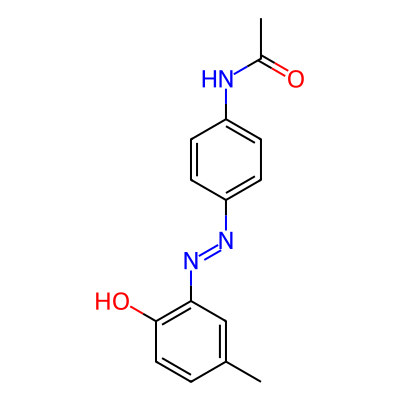
C.I. Disperse Yellow 3
| Associated High Confidence AOPs |
|---|
Associated AOPs with Level of Relevance 1
| AOP Identifier | AOP Title | AO Classification | OECD Status | Coverage Score | KE Identifier | KE Name |
|---|---|---|---|---|---|---|
| AOP:18 | PPARα activation in utero leading to impaired fertility in males | Reproductive System Disease | Under Review | 0.12 | KE:289 | Decrease, Translocator protein (TSPO) |
| AOP:107 | Constitutive androstane receptor activation leading to hepatocellular adenomas and carcinomas in the mouse and the rat | Cancer; Gastrointestinal System Disease | Under Review | 0.2 | KE:1214 | Altered gene expression specific to CAR activation, Hepatocytes |
| AOP:112 | Increased dopaminergic activity leading to endometrial adenocarcinomas (in Wistar rat) | Reproductive System Disease; Cancer | - | 0.17 | KE:111 | Agonism, Estrogen receptor |
| AOP:206 | Peroxisome proliferator-activated receptors γ inactivation leading to lung fibrosis | Musculoskeletal System Disease; Respiratory System Disease | Under Development | 0.17 | KE:1271 | Activation of TGF-β signaling |
| AOP:347 | Toll-like receptor 4 activation and peroxisome proliferator-activated receptor gamma inactivation leading to pulmonary fibrosis | Musculoskeletal System Disease; Respiratory System Disease | - | 0.22 | KE:1795 | Latent Transforming growth Factor beta expression |
| KE:1283 | Activation, TGF-beta pathway | |||||
| AOP:414 | Aryl hydrocarbon receptor activation leading to lung fibrosis through TGF-β dependent fibrosis toxicity pathway | Musculoskeletal System Disease; Respiratory System Disease | - | 0.2 | KE:1920 | Altered gene expression, TGF-β dependent fibrosis pathway |
| AOP:420 | Aryl hydrocarbon receptor activation leading to lung cancer through sustained NRF2 toxicity pathway | Cancer | - | 0.25 | KE:1917 | Altered gene expression, NRF2 dependent antioxidant pathway |
| AOP:449 | Ceramide synthase inhibition leading to neural tube defects | Neural Tube Defect | - | 0.14 | KE:1502 | Histone deacetylase inhibition |
| AOP:511 | The AOP framework on ROS-mediated oxidative stress induced vascular disrupting effects | Cardiovascular System Disease | - | 0.06 | KE:2171 | Activated BMP/TGF-beta pathway |
No associated AOPs with Level of Relevance 2
Associated AOPs with Level of Relevance 3
| AOP Identifier | AOP Title | AO Classification | OECD Status | Coverage Score | KE Identifier | KE Name |
|---|---|---|---|---|---|---|
| AOP:8 | Upregulation of Thyroid Hormone Catabolism via Activation of Hepatic Nuclear Receptors, and Subsequent Adverse Neurodevelopmental Outcomes in Mammals | Nervous System Disease | Under Development | 0.11 | KE:239 | Activation, Pregnane-X receptor, NR1l2 |
| AOP:212 | Histone deacetylase inhibition leading to testicular atrophy | Reproductive System Disease | WPHA/WNT Endorsed | 0.17 | KE:1502 | Histone deacetylase inhibition |
| AOP:241 | Latent Transforming Growth Factor beta1 activation leads to pulmonary fibrosis | Musculoskeletal System Disease; Respiratory System Disease | - | 0.33 | KE:1469 | Activation, Transforming Growth Factor beta pathway |
| KE:1468 | Activation, Latent Transforming Growth Factor Beta 1 | |||||
| AOP:274 | Histone deacetylase inhibition leads to impeded craniofacial development | Musculoskeletal System Disease | - | 0.25 | KE:1502 | Histone deacetylase inhibition |
| AOP:275 | Histone deacetylase inhibition leads to neural tube defects | Neural Tube Defect | - | 0.2 | KE:1502 | Histone deacetylase inhibition |
| AOP:288 | Inhibition of 17α-hydrolase/C 10,20-lyase (Cyp17A1) activity leads to birth reproductive defects (cryptorchidism) in male (mammals) | Endocrine System Disease | - | 0.12 | KE:1609 | Inhibition, Cytochrome P450 enzyme (CYP17A1) activity |
| AOP:447 | Kidney failure induced by inhibition of mitochondrial electron transfer chain through apoptosis, inflammation and oxidative stress pathways | Urinary System Disease | - | 0.08 | KE:1917 | Altered gene expression, NRF2 dependent antioxidant pathway |
| AOP:517 | Pregnane X Receptor (PXR) activation leads to liver steatosis | Gastrointestinal System Disease; Inherited Metabolic Disorder | - | 0.2 | KE:239 | Activation, Pregnane-X receptor, NR1l2 |
| AOP:536 | Estrogen receptor agonism leading to reduced survival and population growth due to renal failure | Unclassified | - | 0.17 | KE:111 | Agonism, Estrogen receptor |
| AOP:537 | Estrogen receptor agonism leads to reduced fecundity via increased vitellogenin in the liver | Unclassified | - | 0.2 | KE:111 | Agonism, Estrogen receptor |
| AOP:545 | Activation, Pregnane-X receptor, NR1l2 leads to increased plasma low-density lipoprotein (LDL) cholesterol via increased cholesterol synthesis | Unclassified | - | 0.2 | KE:239 | Activation, Pregnane-X receptor, NR1l2 |
| AOP:548 | Activation, Pregnane-X receptor, NR1l2 leads to increased plasma low-density lipoprotein (LDL) cholesterol via increased PCSK9 protein expression | Unclassified | - | 0.2 | KE:239 | Activation, Pregnane-X receptor, NR1l2 |
No associated AOPs with Level of Relevance 5
DISCLAIMER
TICToK is a database of tattoo ink chemicals compiled from different regulatory resources. The authors are not liable for any inaccuracies or omissions of any chemicals in this resource. Importantly, our sole goal to build this resource on tattoo ink chemicals is to enable future basic research on this topic, and it does not necessarily reflect the views or objectives of our employers or funders.